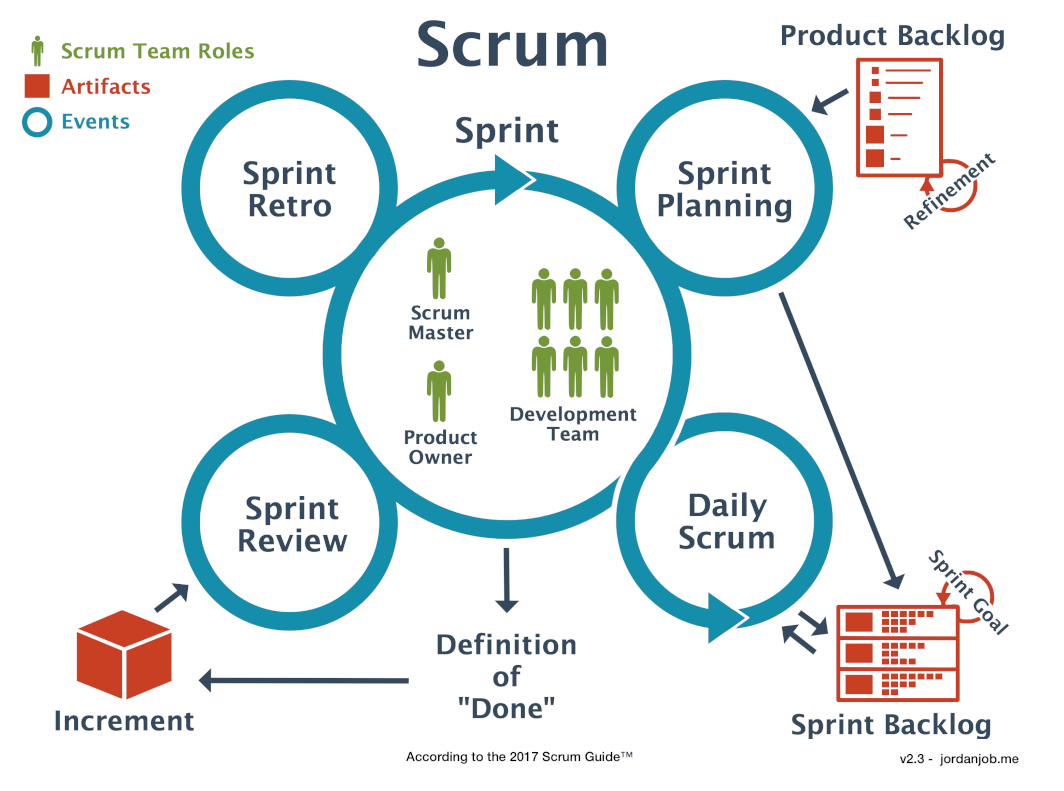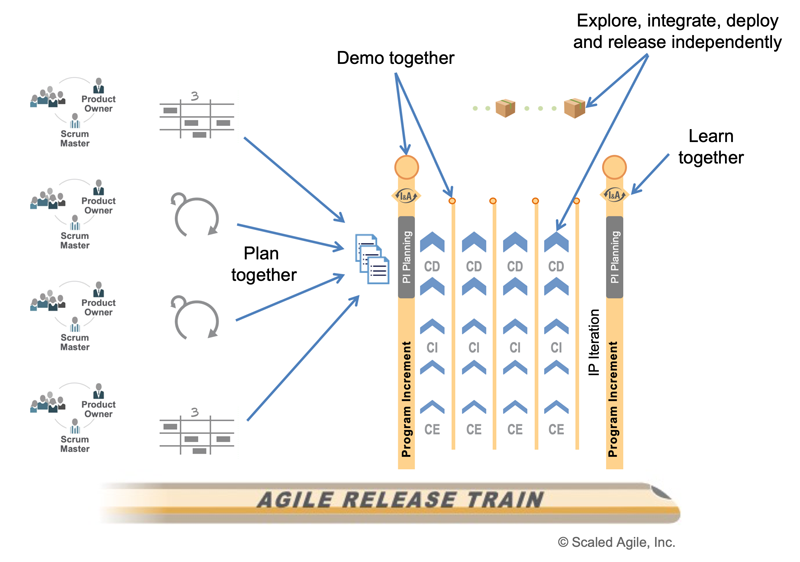Contents
Scaled Agile Framework (SAFe) Cheatsheet
The SAFe framework is the Agile framework by which SKA delivers value.
Acronyms
| Acronym | Description |
|---|---|
| ART | Agile Release Train |
| CDP | Continuous Delivery Pipeline |
| C | Continuous Deployment |
| CE | Continuous Exploration |
| CI | Continuous Integration |
| MMF | Minimum Marketable Feature |
| MVP | Minimum Viable Product |
| IP | Innovation and Planning |
| PI | Program Increment |
| PO | Product Owner |
| RoD | Release On Demand |
| RTE | Release Train Engineer |
| SM | Scrum Master |
| STE | Solution Train Engineer |
Definitions
An Agile Team is a cross-discipline group of 5-11 individuals who define, build, test, and deliver an increment of value in a short time box. The team has two speciality roles: Scrum Master and Product Owner.
The Scrum Master (SM) is a team coach, whose duty it is to foster an environment for high performance, continuous flow and improvement.
The Product Owner (PO) defines Stories and prioritises them, whilst maintaining the conceptual and technical integrity of Features the team is responsible for.
Stories are short descriptions of a small piece of desired functionality sized so they can be completed in a single Iteration. Stories make up the Team Backlog, and are expressed in the user's voice, e.g. "As a (user role), I want to (activity) so that (value)". Stories can be Enablers.
An Enabler supports the activities needed to extend the Architectural Runway to provide future business functionality. These include exploration, architecture, infrastructure, and compliance. Enablers are captured in the various backlogs and occur throughout the framework.
The Architectural Runway consists of the existing code, components, and technical infrastructure needed to implement near-term features without excessive redesign and delay.
A Feature is a service that fulfils a stakeholder need. Each feature includes a benefit hypothesis and acceptance criteria.
Iterations are fixed-length timeboxes that provide the development cadence for Agile Teams building Features. Each Iteration delivers a valuable increment of new functionality. One type of Iteration is a Sprint.
A Sprint is a type of Iteration following the Scrum methodology. It proceeds via four sequential stages and works to deliver Features from Stories on the Team Backlog:
-
Iteration Planning is an event in which an Agile team determines the goals for the Iteration, and how much of the Team Backlog they can commit to.
-
An Iteration Execution is how the Agile Team develops an increment of a high-quality, working, tested system within the timebox. Progress through an Iteration Execution is monitored by the use of e.g. Kanban boards and daily stand-up meetings.
-
An Iteration Review is a cadence-based event at the end of each Iteration Execution in which the team reviews the previous Increment's results and adjusts the Team Backlog based on feedback.
-
The Iteration Retrospective is an event held at the end of an Iteration cycle for the Agile Team to review its practices and identify ways to improve. The retrospective is based on the qualitative and quantitative information presented during the Iteration Review.
In addition, Backlog Refinement is an event held once or twice during the Iteration to refine, review, and estimate future Stories and Enablers in the Team Backlog.

The Team Backlog contains Stories that originate from the the Program Backlog, as well as Stories that arise from the team's local context. Team Backlog's are the responsibility of the Product Owner. It contains a list of "want to do" items and Non-functional Requirements.
Non-functional Requirements are constraints or restrictions on attributes of the system such as security, reliability, performance, maintainability, scalability, and usability. They are common to all Team Backlogs, and form part of the Solution Intent.
Solution Intent is a repository for storing, managing, and communicating the knowledge of current and intended Solution behaviour. Where required, this includes both fixed and variable specifications and designs; reference to applicable standards, system models, and functional and non-functional tests; and traceability.
The Program Backlog is the holding area for upcoming Features, which are intended to address user needs and deliver business benefits for a single Agile Release Train.
The Agile Release Train (ART) is a long-lived team of Agile Teams, which, along with other stakeholders, incrementally develops, delivers, and where applicable operates, one or more Solutions in a Value Stream. ARTs are led by Release Train Engineers.
A Release Train Engineer (RTE) is a servant leader who facilitates program execution, impediment removal, risk and dependency management, and continuous improvement.
Value Streams represent the series of steps that an organisation uses to implement Solutions. There are two types of stream: operational and development. The former contains the steps and people who deliver end-user value using the Solutions created by the development value streams. The latter contains the steps and the people who develop the Solutions used by operational value streams.
Solutions are products, services, or systems delivered to the customer. In Essential SAFe, each ART has the ability to deliver a largely independent solution to the customer. Large Solution SAFe supports solutions that require multiple ARTs, which form a Solution Train. ARTs function simultaneously to build the solution in fully integrated increments, measurable via a Solution Demo that occurs at least during every Program Increment.

A Solution Train is a construct used to build large and complex Solutions that require the coordination of multiple ARTs. The Solution Train is facilitated, akin to the Scrum Master, by a Solution Train Engineer.
The Solution Train Engineer (STE) is the servant leader of the Solution Train. Their oversight allows the Solution Train to run smoothly by identifying and resolving bottlenecks across the entire Solution.
A Program Increment (PI) typically lasts 8 – 12 weeks long. The most common pattern for a PI is four development Iterations followed by one Innovation and Planning iteration.
The Innovation and Planning (IP) Iteration provides Agile Teams with an opportunity for exploration and innovation, dedicated time for planning, and learning through informal and formal channels.
The Solution Backlog is the holding area for upcoming Capabilities and Enablers, each of which can span multiple ARTs and is intended to advance the Solution and build its architectural runway.
A Capability is a higher-level solution behaviour that typically spans multiple ARTs. Capabilities are sized and split into multiple features to facilitate their implementation in a single PI.

The Roadmap is a schedule of events and Milestones that communicate planned Solution deliverables over a planning horizon. SAFe defines two types of roadmaps: A near-term PI Roadmap and a longer-term Solution Roadmap. A PI roadmap includes near-term commitments for an ART or Solution Train for the planned, upcoming Program Increment (PI) and offers a forecast into the deliverables and milestones for the next two to three PIs. The Solution Roadmap provides a longer-term view showing the key milestones and deliverables needed to achieve the solution Vision over time.
Milestones are used to track progress toward a specific goal or event. There are three types of SAFe milestones: PI, fixed-date (non-cadence), and learning milestones.
A Vision is a description of the future state of the Solution under development. It reflects customer and stakeholder needs, as well as the Feature and Capabilities proposed to meet those needs.
An Epic is a container for a significant Solution development initiative that captures the more substantial investments that occur within a portfolio. Portfolio Epics are typically cross-cutting, typically spanning multiple Value Streams and PIs.
A core principle of SAFe is the Continuous Delivery Pipeline (CDP), which represents the workflows, activities, and automation needed to shepherd a new piece of functionality from ideation to an on-demand release of value to the end user. It is comprised of four aspects: Continuous Exploration, Continuous Integration, Continuous Deployment, and Release on Demand, each of which is described in its own article.

Continuous Exploration (CE) focuses on creating alignment on what needs to be built. It starts with an idea or a hypothesis of something that will provide value to customers, typically in response to customer feedback or market research. Ideas are then analysed and further researched, leading to the understanding and convergence of what is needed as either a Minimum Viable Product or Minimum Marketable Feature. These feed the solution space of exploring how existing architectures and solutions can, or should, be modified. Finally, convergence occurs by understanding which Capabilities and Features, if implemented, are likely to meet customer and market needs. Collectively, these are defined and prioritised in the Program Backlog.
A Minimum Viable Product (MVP) is the version of a new product which allows a team to collect the maximum amount of validated learning about customers with the least effort.
A Minimum Marketable Feature (MMF) is the smallest set of functionality in a product that must be provided for a customer to recognise any value.
Continuous Integration (CI) focuses on taking features from the Program backlog and implementing them. After specific features are clearly understood, Agile Teams implement them. Completed work is committed to version control, built and integrated into a full system or solution, and tested end-to-end before being validated in a staging environment.
Continuous Deployment (CD) takes the changes from the staging environment and deploys them to production. At that point, they’re verified and monitored to make sure they are working properly. This step makes the features available in production, where the business determines the appropriate time to release them to customers. This aspect also allows the organisation to respond, rollback, or fix forward when necessary.
Release on Demand (RoD) is the ability to make value available to customers all at once, or in a staggered fashion based market and business needs.
Resources
[1] https://www.scaledagileframework.com/essential-safe/ is the official documentation for the SAFe framework.
[2] https://www.youtube.com/watch?v=aW2m-BtCJyE is a good (quick) 5 minute guide on SAFe and provides a good starting point for this document.
[3] https://www.amazon.co.uk/Scrum-Doing-Twice-Work-Half/dp/038534645X is a particularly useful starting reference if unfamiliar with Scrum, written by one of the guy's who invented it.
[4] https://www.edx.org/professional-certificate/umd-usmx-agile-project-management is a free self-paced MOOC on the subject of Agile.
References
© Scaled Agile, Inc. Include this copyright notice with the copied content.
Read the FAQs on how to use SAFe content and trademarks here: https://www.scaledagile.com/about/about-us/permissions-faq/ Explore Training at: https://www.scaledagile.com/training/calendar/